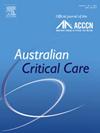Effectiveness of virtual reality on anxiety, pain, sleep quality, and post-traumatic stress disorder for critically ill patients in intensive care units: A systematic review and meta-analysis of randomised controlled trials
IF 2.7
3区 医学
Q2 CRITICAL CARE MEDICINE
引用次数: 0
Abstract
Objectives
The aim of this study was to determine the effectiveness of virtual reality on anxiety, pain, sleep quality, and posttraumatic stress disorder in critically ill patients within intensive care units.
Data sources
The data sources included PubMed, EMBASE, Web of Science, CENTRAL, PsycINFO, and CINAHL DATA databases.
Methods
Two authors independently conducted the literature search and quality assessment process. The pooled results were calculated using the standardised mean difference (SMD) and its 95% confidence interval (CI) using the Review Manager software (Version 5.4).
Results
Ten randomised controlled trials published from 2020 to 2024 were included. Most of the studies were classified as having a low risk of bias or some concerns. The evidence certainty varied from low to moderate for the different outcomes. The pooled results indicated statistically significant effectiveness in anxiety (SMD: −0.46, 95% CI: −0.80 to −0.11, P = 0.01) and sleep quality (SMD: 0.66, 95% CI: 0.29–1.03, P < 0.001) postintervention. No statistically significant effects were found for pain (SMD: −0.11, 95% CI: −0.79–0.57, P = 0.75) or posttraumatic stress disorder (SMD: −0.29, 95 % CI: −0.59–0.02, P = 0.06).
Conclusions
Virtual reality is practical for mitigating anxiety and enhancing sleep quality in critically ill patients within intensive care units; however, its effects on pain and posttraumatic stress disorder are nonsignificant. Virtual reality can broaden its utility and content within intensive care units by incorporating meditation, hypnosis, and cognitive behavioural strategies. Careful consideration should be given to the timing and frequency of virtual reality sessions for patients who are critically ill and unable to remain conscious.
Implications for clinical practice
Virtual reality is a promising complementary therapy in intensive care units. It can reduce anxiety and improve sleep quality. Still, its effects on pain and posttraumatic stress disorder are not significant, and future research should focus on optimising devices, expanding content, and selecting appropriate intervention timing and frequency.
虚拟现实对重症监护病房危重病人焦虑、疼痛、睡眠质量和创伤后应激障碍的有效性:随机对照试验的系统回顾和荟萃分析
目的本研究的目的是确定虚拟现实对重症监护病房危重患者焦虑、疼痛、睡眠质量和创伤后应激障碍的有效性。数据来源包括PubMed、EMBASE、Web of Science、CENTRAL、PsycINFO和CINAHL Data数据库。方法由两位作者独立进行文献检索和质量评价。使用Review Manager软件(Version 5.4)使用标准化平均差(SMD)及其95%置信区间(CI)计算合并结果。结果纳入2020 - 2024年发表的10项随机对照试验。大多数研究被归类为低偏倚风险或有一些担忧。不同结果的证据确定性从低到中等不等。综合结果显示,在焦虑(SMD: - 0.46, 95% CI: - 0.80至- 0.11,P = 0.01)和睡眠质量(SMD: 0.66, 95% CI: 0.29-1.03, P <;0.001) postintervention。对疼痛(SMD: - 0.11, 95% CI: - 0.79-0.57, P = 0.75)或创伤后应激障碍(SMD: - 0.29, 95% CI: - 0.59-0.02, P = 0.06)无统计学显著影响。结论虚拟现实技术在减轻重症监护病房危重病人焦虑和提高睡眠质量方面具有实用价值;然而,它对疼痛和创伤后应激障碍的影响不显著。虚拟现实可以通过结合冥想、催眠和认知行为策略来扩大其在重症监护病房的实用性和内容。对于危重患者和无法保持意识的患者,应仔细考虑虚拟现实治疗的时间和频率。虚拟现实技术在重症监护病房是一种很有前途的辅助疗法。它可以减少焦虑,提高睡眠质量。然而,其对疼痛和创伤后应激障碍的影响并不显著,未来的研究应侧重于优化设备,扩大内容,选择适当的干预时间和频率。
本文章由计算机程序翻译,如有差异,请以英文原文为准。
求助全文
约1分钟内获得全文
求助全文
来源期刊

Australian Critical Care
NURSING-NURSING
CiteScore
4.90
自引率
9.10%
发文量
148
审稿时长
>12 weeks
期刊介绍:
Australian Critical Care is the official journal of the Australian College of Critical Care Nurses (ACCCN). It is a bi-monthly peer-reviewed journal, providing clinically relevant research, reviews and articles of interest to the critical care community. Australian Critical Care publishes peer-reviewed scholarly papers that report research findings, research-based reviews, discussion papers and commentaries which are of interest to an international readership of critical care practitioners, educators, administrators and researchers. Interprofessional articles are welcomed.
 求助内容:
求助内容: 应助结果提醒方式:
应助结果提醒方式:


